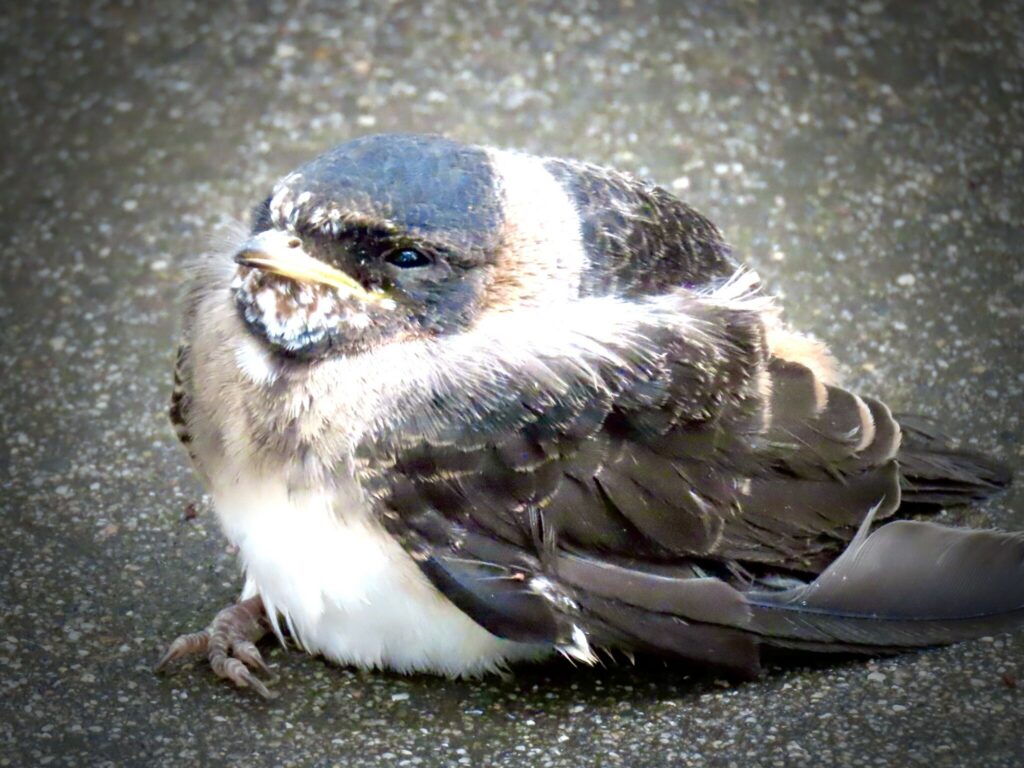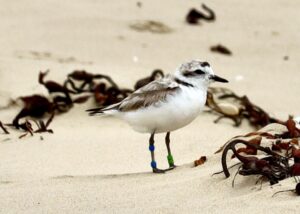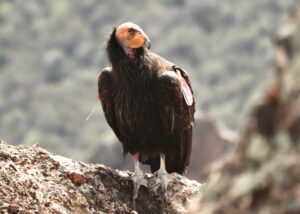One June morning, I came home to find a small, obviously frightened bird hunkered down in front of my house. Mostly brown and white, she had a touch of blue on her crown. Her feathers were bedraggled as if she’d just woken up from a nap. A cliff swallow, likely a juvenile. They build mud nests underneath eaves and bridges and vertical cliffs. Eat insects they catch in flight. We’d had a blustery rain storm the previous day and I wondered if she’d been blown off-course.
I called Pacific Wildlife Care where a cheery-sounding woman answered the phone. Can you bring her in? I went back inside to scrounge up a soft towel and a shoebox. (Later, I realized she could easily have been scooped up by one the many red-tailed hawks that inhabit the trees around my house.) But when I came out again, there she was, crouched down, breathing heavily. She didn’t fight me when I carefully lifted her into my makeshift nest. On the drive out to Morro Bay, I had to resist the urge to open the box. Was she still alive? I cooed at her the whole way.
The wildlife center is located down a narrow road in a cobbled-together tangle of concrete block buildings and trailers. I knocked on the heavy metal door. A young woman answered, and I exchanged the box for a card with the bird’s number on it. “You can call in a couple of days,” she said, and quickly disappeared inside.
I felt emptied-handed, abandoned. I expected to be welcomed in, but it was obvious the woman had more important things to do than give me a tour of their facility. Or reassure me that my bird would be okay.
My bird. How had I come to care about her so quickly?
In the next couple of days, I carried her with me. On my walks. Washing dishes. Raking leaves. Did I want to know how she was faring? Yes, of course—if she was okay.
But if she’d died? Then, like Charles Darwin, I longed to feel more dispassionate about her fate. A baby bird blown off-course so easily wouldn’t be able to fend off the vast array of predators—hawks and gulls, raccoons, snakes, fire ants, and bullfrogs. Not to mention the neighborhood cats. And who was going to protect her? Teach her how to search for food? How to build a nest?
Two days later, I held my breath as the woman went to look up my bird’s number. Even if she’d died, my bird should have had a name. Cliff or Sally or Stormy. On second thought, if she’d died, maybe a number was better.
The woman came back on the line. “The bird’s doing fine,” she said. “Just dehydrated and we put it under a heat lamp.”
It took a moment for the news to settle in. “What will happen now?”
“We release the birds, when they’re ready. This one, probably to a colony of swallows along the coast.”
A few weeks later, I got a postcard in the mail, letting me know that they’d transferred my cliff swallow for specialized care up north. I reread the postcard. Specialized care. At Native Songbird Care & Conservation in Sebastopol. Someone had driven my little bird, probably with other sick and dehydrated songbirds, to a specialized facility five hours away. The card read: Thanks to your kindness, we have been able to return the bird to its free and wild life.
As it turns out, she wasn’t my bird. She was our bird. Like the flock of scientists committed to saving the California condor from lead poisoning. Or the gaggle of bird watchers during Christmas count. Or the colony of advocates desperate to prevent off-road vehicles from destroying plover habitat. There’s a whole bevy of ornithologists and citizen scientists and volunteers doing their utmost to save our birds.
I put that postcard on my refrigerator—to remind me I’m not alone. And that one bird at a time, we all care together.
For more blog posts like this one, see Nesting in Place: How a Few Backyard Birds are Teaching Me to Listen.
Also both my novels, Thin Places and Cross Body Lead, are available locally at Volumes of Pleasure and wherever books are sold.



What a lovely post, Elie! This a a good reminder of our caring connections as we begin a New Year. I send you love and good wishes.
Thank you so very much for sharing this.
Beautiful, touching story, Elie. Thanks!
So touching How do these little creatures capture our hearts quickly?
Such a beautiful story, and beautifully told. Gave me chills, in the best possible. Thank you!
A tender story Elie, thank you for your insightful sharing of thoughts and words.
Touching story and I loved the photo of the beautiful little bird you found in your driveway.
A lovely story, so well written. Caring connections, not just with nature, enhance our lives. Thank you for sharing.
Happy New Year!
Judy
Thank you Judy! The whole experience was touching and poignant, and I was happy to share the story.
Beautiful!
Oh, Elie…What a touching story of how thoughtful acts of kindness matter on so many levels. Love your writing.
Beautifully written, Elie. A reminder of the fragility of life and the network we have to support us.
WOW! What a heartwarming story! We need more of these tidbits to cheer us as we deal with all the challenging news these days. I love the “personal note” you received & who would have expected your little feathered friend would have been transported to another facility.
Thx for sharing! Happy New Year Elie.